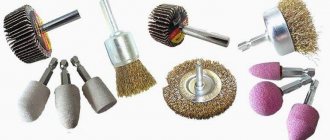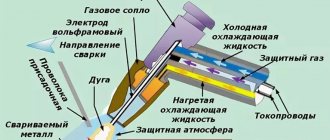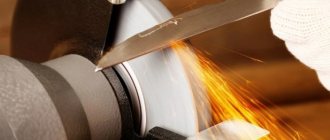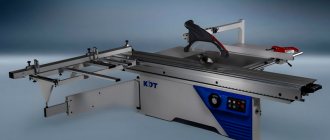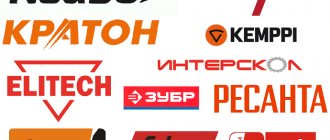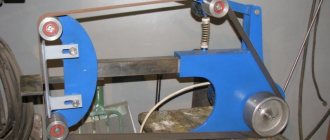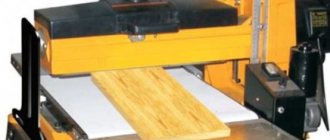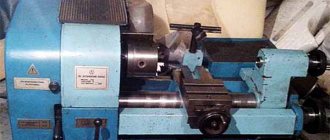A grinding machine is a device used to process workpieces made of various materials with an abrasive tool and can provide surface roughness from 0.02 to 1.25 microns. Grinding machines, which can have different designs, allow you to effectively solve problems associated with processing the surfaces of parts made of different materials.
One of the many types of grinding machines
Why do you need a grinding machine?
The purpose of the grinding machine is clear from the name itself - it is designed for grinding. That is, this mechanism is designed to process material (be it wood or metal). The goal is to achieve the lowest possible degree of roughness of the product. In some cases, grinding machines are also used to adjust any objects to the required dimensions (for example, you need to reduce the radius of a part).
Grinding machines are actively used in construction work. They are used when you need to polish boards and give them the smoothest surface possible. Most often, such “operations” are carried out before varnishing - in order to coat wood with any impregnation, you first need to clean it of wooden burrs.
Grinding machines are also used in factories. If a product or part turns out to be too large during production, it can be sanded. This will remove the excess layer of material and the product will acquire the desired appearance.
Grinding machine
Computer numerical control
CNC has been developed over the years in order to increase productivity and simplify the task, increasing the accuracy of the resulting dimensions. The drawings of many parts have dimensions with minimal tolerances; it is impossible to use hand tools to solve such a task. Therefore, if the drawings have such tolerances, a mechanized processing method should be used.
Many problems prevented the use of numerical control when creating a grinding machine. An example is the lubrication system, as well as spindle positioning. CNC control determines high-precision positioning of the spindle and automation of the lubrication system.
Despite the huge number of advantages of the CNC system, it is quite difficult to find a design with similar automation technology. This is due to the fact that such equipment is used extremely rarely in large-scale and mass production.
The CNC determines the exact positioning of the spindle. However, it is worth considering that the spindle must be positioned taking into account the equipment used. Therefore, the drawing indicates what kind of equipment is used for grinding machines.
Maintenance of a CNC design becomes much more difficult, since changes can lead to malfunction. Equipment should be adjusted periodically to maintain dimensional accuracy and roughness quality.
There are quite a few types of CNC systems, which are divided by the type of program used to describe the trajectory of the abrasive wheel, describe the spindle speed and feed rate.
Types of grinding machines
Depending on their purpose, grinding machines are divided into several types. Each of them is different in structure and internal characteristics. Let's look at the main types of grinding machines:
- Cylindrical grinders. Used to process cylindrical products. They themselves are also universal and non-universal. In universal models, it is possible to rotate both the work table and the workpiece itself, and in some cases, the grinding wheel. Non-universal models do not have this function.
- Surface grinding. Designed for grinding flat surfaces that have a minimum angle of curvature.
- Centerless grinding. This type of machine is intended for mass processing and grinding of surfaces.
- Honing. Used for “delicate” grinding. During operation, the machine removes small layers of material from the surface of the product (their thickness can be only a few hundredths of a millimeter).
Main types of grinding machines
Video - Review of tabletop belt-disc sanding machines for wood
Classification of grinding equipment
Depending on the application, grinding machines are divided into a number of types.
Cylindrical grinders
This equipment is designed for grinding cylindrical (Ø 25–600 mm) and conical workpieces. Such machines have in their design a spindle that rotates in a horizontal plane, which can move on a special slide. The part to be machined may be clamped in the chuck or between the centers of the tailstock and headstock.
Cylindrical grinding machine
Universal cylindrical grinding
machines Such machines are used for grinding the outer and end surfaces of cylindrical workpieces (Ø 25–300 mm), as well as conical parts. To perform processing, workpieces can be fixed in centers or in a chuck.
Universal cylindrical grinding machine
Plunge cylindrical grinding
Grinding machines of this type are used for processing cylindrical (Ø 150–400 mm), conical and profile workpieces, which are fixed in the centers of the equipment. Processing is carried out due to the transverse movement (cutting) of the abrasive wheel.
Plunge cylindrical grinding machine
Centerless cylindrical grinding
Processing on such equipment can be performed according to two schemes: by pass (cylindrical surfaces (Ø 25–300 mm)) and by plunge method (cylindrical, conical and profile surfaces). A distinctive feature of grinding machines of this type is that their design does not provide centers for fixing workpieces.
Centerless cylindrical grinding machine
Roll grinding
This includes machines for grinding rolling rolls of cylindrical, conical and profile configurations. Fixation of workpieces on machines of this type is carried out using equipment centers.
Roll grinding machine
For grinding crankshaft journals
On such machines, working using the plunge method, simultaneous or sequential grinding of the crankpins of crankshafts is performed.
Machine for grinding crankshaft journals
Internal
These devices allow you to process cylindrical and conical holes in a wide range of sizes (with a diameter of 1–10 cm on a benchtop grinding machine and up to 100 cm on a production one).
Internal grinding machine
Surface grinding
Processing on such equipment is performed with the end or periphery of the abrasive wheel. Grinding machines of this type can be equipped with additional devices, which makes it possible to process metal workpieces of complex configurations. Depending on the location of the spindle, surface grinding machines can be horizontal or vertical. The design of such devices may also include one or two columns.
Surface grinding machine
Double-sided surface grinding
This equipment can simultaneously process two flat surfaces, which significantly increases its productivity. Such grinding machines, in which the workpieces are fixed on a special feeding device, can be of a vertical or horizontal type.
Double-sided surface grinder
For grinding guides
The maximum length of guides that can be processed using these grinding machines is 1000-5000 mm. Guides of these types are equipped with beds, work tables, slides and other equipment components for various purposes.
Universal sharpening
Such grinding machines are used for sharpening various tools with a maximum diameter of 100–300 mm (taps, reamers, countersinks, cutters, etc.). The technical capabilities of equipment of this type make it possible to equip it with additional devices for processing cylindrical workpieces, as well as for internal and end grinding.
Universal sharpening machine
Roughing and grinding
This grinding equipment is used for roughening and cleaning the surface of workpieces by grinding. These machines use abrasive wheels with a diameter of 100–800 mm.
Roughing and grinding machine
Flat-lapping
This grinding equipment is used to perform grinding of workpieces with flat and cylindrical surfaces. The diameter of the abrasive discs that are installed on such machines is 200–800 mm.
Flat lapping machine
Round lapping
On this equipment, lapping of calibration and measuring tools made of metal is performed. The maximum diameter of gauges and tools that can be processed on machines of this type is 50–200 mm.
Grinding and lapping
With the help of such equipment, holes are ground in, the maximum diameter of which is 100–300 mm.
Grinding and lapping machine
Grinding and finishing
These are machines designed to perform finishing (lapping) operations. Such devices process various metal products: crankshafts with a maximum diameter of 100–200 mm, equipment spindles, pistons, etc.
Polishing
Such machines are used to polish metal parts. This universal equipment can be used to polish flat, cylindrical, conical, internal surfaces, as well as workpieces of complex configurations. An endless belt with a width of 100–200 mm or a soft polishing wheel with a diameter of 100–200 mm can be used as a working tool on these machines.
Grinding and polishing machine
Honing
There are also honing machines that are used to perform fine grinding (0.04–0.08 mm per diameter).
Honing machine
Which is the best grinding machine to choose in 2022
Buying a machine is an individual decision for everyone. Therefore, it is impossible to single out any best grinding machine. So, for budget buyers, the best option would be the Einhell TC-US 400 or Zubr ZShS-330. For frequent use, it is worth purchasing a Holzstar ZSM 405 or JET 31A 2685033 machine. For those who have not yet decided on their choice, we have specially collected all the models discussed in the article in one comparative table:
| Name | Weight, kg.) | Belt rotation speed (rpm) | Cost, rub.) |
| 7,6 | 2950 | 6.500–7.000 |
| 7 | 2850 | 8.000–8.500 |
| 12,9 | 1450 | 9.000–9.500 |
| 18 | 1420 | 9.500–10.000 |
| 17 | 1450 | 11.000–11.500 |
| 20 | 1450 | 14.000–14.500 |
| 19 | 2850 | 15.000–16.500 |
| 34 | 1430 | 18.000–19.000 |
| 13 | 2000 | 25.000–28.000 |
| 145 | 2950 | 65.000–70.000 |
| 44 | 1400 | 70.000–75.000 |
| 80 | 1440 | 80.000–85.000 |
| 115 | 2400 | 90.000–96.000 |
Surface grinding machine with round tables
Machines with round tables are designed for processing surfaces of round workpieces: rings, flanges, disks and other products with a roughness tolerance of 1.25–0.02. The table rotation is realized using a high-precision mechanism powered by an electric drive.
From us you can purchase machines with round tables measuring 200–400 mm with a maximum distance to the spindle center of 180–30 mm. If necessary, surface grinding machines of this type can be equipped with programmable controllers to control the movement of the table in the vertical plane.
Tips and tricks when choosing a grinding machine
In order not to make a mistake when choosing a grinding machine, you need to know some nuances. Now we will give tips that will help you when choosing a quality device:
- Before choosing, be sure to inspect the machine for mechanical damage. If they are present, then perhaps the machine is used (not new);
- Also, before purchasing, you should definitely start the device and check its performance. Very often, buyers do not do this when purchasing, and they may be sold low-quality, defective goods;
- When choosing, you should also take into account the characteristics of the machine. You need to pay attention to the maximum engine power, the presence of safety systems, the strength of the body and the resistance on the frame. Also important indicators of the machine are its endurance during long-term operation and resistance to temperature changes.
Video - Choosing a grinding machine for the workshop
Voting for the best grinding machine
Which grinding machine would you choose or recommend?
JET 31A 2685033
0.00 % ( 0 )
Holzstar ZSM 405
0.00 % ( 0 )
Jet 10-20 PLUS 628900M
23.08 % ( 3 )
VISPROM BKL-3000
0.00 % ( 0 )
Triton TSPST450 TR894303
7.69 % ( 1 )
JET JDS-12X-M 10000490M
7.69 % ( 1 )
Record Power BDS150-EP
15.38 % ( 2 )
JET JSG-64
15.38 % ( 2 )
Proma BP-100 25702100
7.69 % ( 1 )
Encore Corvette-51 90510
0.00 % ( 0 )
Einhell TC-US 400
7.69 % ( 1 )
JET JDBS-5-M 10000470M
15.38 % ( 2 )
Surface grinding machine with cross tables
Machines of this type are designed for processing small flat workpieces with the end or peripheral edge of a grinding wheel with a roughness tolerance of 1.25–0.02. The fixed column is equipped with guides for moving the table in the longitudinal and/or transverse plane.
The catalog contains five modifications:
- M - with manual control;
- H - longitudinal displacement using a hydraulic cylinder;
- AH - semi-automatic machines with programmable controllers (PLC) for setting the processing width, number of passes, cutting depth and other parameters;
- ADP - semi-automatic machines with PLC, touch screens and servos;
- CNC - CNC surface grinding machines.

